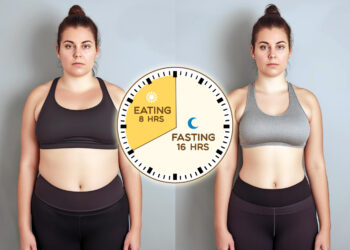Fasting has been around for ages. However, the 14/10 and 16/8 intermittent fasting (IF) methods have been gaining popularity over the last few years. Both of these are similar but quite different. Which method to follow? Do they work? Are there any downsides? We answer all these questions in this article.
Many people fast with the goal of losing fat. Intermittent fasting has an impressive list of benefits, including improved cognition, better cardiovascular health, and overall weight loss. It also reduces insulin resistance and boosts longevity. [1] [2] [3] [4]
Key Takeaways
- Both 14/10 and 16/8 intermittent fasting methods involve fasting for a significant part of the day.
- After you master the 12/12 or 14/10 intermittent fasts, if you feel that you are able to commit to a prolonged fast (16/8), then it is not a bad idea to try this program.
What is Intermittent Fasting?
Intermittent fasting is a diet plan where you fast for a certain number of hours per day and eat only during a fixed feeding window. This method helps shed weight and improve overall health. In this eating pattern, you are only allowed to eat during a specific period, and the eating window length depends on the fasting method you choose.
However, one essential question remains — how many hours should you fast to reap all the incredible benefits of intermittent fasting? Is there a minimum number of hours you need to fast to get all the perks associated with intermittent fasting?
In this regard, we will explore two fasting methods — the 14/10 and 16/8 intermittent fast — to understand which is better and yields the best results.
Level Up Your Fitness: Join our 💪 strong community in Fitness Volt Newsletter. Get daily inspiration, expert-backed workouts, nutrition tips, the latest in strength sports, and the support you need to reach your goals. Subscribe for free!
What is 16/8 Intermittent Fasting?
16/8 intermittent fasting is a popular IF method followed by many people worldwide for weight loss. It is a time-restricted fasting method, and you should fast for 16 hours out of the 24 hours of the day. You can eat only in the eight-hour window. For example, if you eat between 11 AM and 7 PM, you will have to fast for 16 hours until 11 AM the following day.
Compared to a 24-hour fast, a 16/8 intermittent fast is set in a more sedate time frame. It is a doable fasting diet that you will not have many problems with. A 16-hour fast might sound intimidating, and it will take some adjusting for your body, but once you get into the rhythm of things, it will be easy. All you are doing is skipping the evening snacks (or dinner) and the following day’s breakfast. If your body does not agree with this fasting schedule, the best thing to do is start with a modified plan that you can slowly tweak towards 16 hours of no eating daily.
What is 14/10 Intermittent Fasting?
The 14/10 method of intermittent fasting follows a similar schedule to the 16/8 plan, with a shorter fasting period and a longer eating window. In this fasting plan, you will be required to fast for 14 hours every day with a 10-hour eating window where you eat balanced meals to meet your daily caloric goals.
Your body will be deprived of calories while fasting. The glucose stores in your body will be depleted quickly, and your body will look for alternative energy sources like fat. After you enter the fasting stage, your body will be in ketosis, where the fat reserves are burned to produce energy. If continuously repeated over the next few days, this process will assist you in burning fat and consequently reducing your weight. [5]
Healthy eating during the 14/10 method is essential as it boosts the overall results you get from intermittent fasting. It’s better to avoid binge eating because it can harm your body and add calories that you will find hard to lose.
If you find the 16/8 IF plan intimidating, you can start with 14/10 intermittent fasting. If you sleep eight hours daily, you will only need to fast for six additional hours and can enjoy the 10-hour feeding window. Practically speaking, 14/10 fasting is easy to implement and also gels with an active social life.
14/10 Intermittent Fasting vs. 16/8 Intermittent Fasting
As the days go by, your body will slowly adjust to the fasting periods, and here, you can start increasing the fasting period for better benefits. The longer you fast, the more time will be available to your body to stay in the autophagy state and work toward cellular health repair.
You can do the 14/10 intermittent fast by eating all your meals in a 14-hour window and not eating anything for the next 10 hours. This is a step up from the 12/12 intermittent fast, and it’s useful if you’re looking to transition to a 16/8 intermittent fast.
Let us look at the differences between the 14/10 and the 16/8 intermittent fasting methods so that you can choose the one most suited to your lifestyle.
Level Up Your Fitness: Join our 💪 strong community in Fitness Volt Newsletter. Get daily inspiration, expert-backed workouts, nutrition tips, the latest in strength sports, and the support you need to reach your goals. Subscribe for free!
Benefits of 14/10 Intermittent Fasting
In intermittent fasting, you will lose weight when your body converts stored fat into energy. Studies have shown that 14/10 intermittent fasting reduces bad cholesterol levels and lowers high blood pressure. Some people also report sleeping better and have increased energy levels. Depending on how your body burns available fat reserves, you may see weight loss and reduced blood sugar levels. [6] [7]
Benefits of 16/8 Intermittent Fasting
In 16/8 intermittent fasting, you will get all the benefits associated with 14/10 IF and more. The most important takeaway is that 16/8 fasting triggers autophagy, where your body will begin to heal itself at the cellular level. 16/8 intermittent fasting is a handy tool to prevent diseases. Many people who follow the 16/8 fasting method have reduced cancer risk and a reduced probability of diabetes and heart disease. [8] [9]
Differences Between 14/10 and 16/8 Intermittent Fasting
Let us take a minute to compare and see how the 14/10 and 16/8 IF methods stack up against each other so that you can figure out which one is better for you.
Fasting Time
When choosing the right intermittent fasting plan, fasting time can be a substantial contributing factor. You are free to eat for 10 hours, provided you schedule your fast optimally; you can use the 14/10 plan to sleep off most of the fasting time. If you can eat dinner at 8 PM and then go to sleep, you can begin eating by 10 AM the following day.
To a lesser extent, the same happens to be true for the 16/8 diet plan. You can sleep for one-half of the fasting period and remain awake for the other. It might be difficult for you not to eat after waking up; however, your body will gradually adjust to this regimen. If you eat your last meal at 6 PM, you can eat again at 10 AM the following day. If you plan precisely and in detail, it will be easy for you to stick to your fasting plan.
Autophagy
During the 14/10 IF plan, your body may or may not enter ketosis, but you will not achieve the state of autophagy. For autophagy to happen, you must fast for at least 16 hours. That is why the 16/8 intermittent fasting plan is so popular.
The goal of most fasting plans is to achieve autophagy. When you achieve this state, you will notice that your body appears and feels much healthier. In autophagy, the damaged and dead cells are purged from the body and replaced with new and healthy cells.
FAQs
What to eat while intermittent fasting?
While intermittent fasting, you are not allowed to have food during the fasting window. However, you could consume drinks with fewer calories, like unsweetened coffee, tea, or water. Plus, there are no restrictions on the foods you can and cannot eat during the feeding window.
What should you not eat during intermittent fasting?
During your eating window while intermittent fasting, avoid processed meats, refined starches, trans fats, and sugar. Go for whole foods like berries, avocados, and lean animal proteins.
Which fruit is best for fasting?
When you break a fast, the first foods you consume are critical from a nourishment point of view. The body should not expend a high amount of energy to digest it. Fruits and fruit juices contain water and are easily digestible; for example, you can go with grapes, watermelon, and apples.
Does lemon water break a fast?
Lemon water does not break fast. Plain lemon water has little to no calories and no sugar. It will not increase your insulin levels and won’t break your fast.
Learn more about fasting
- Anabolic Fasting: Learn About Building Muscle and Losing Fat Simultaneously
- I’m a Fasting Expert: This is the One Mistake That Destroys Fat Loss During IF
- Inflammation Calculator & Personalized Action Plan
- Dry Fasting Calculator: Estimate Your Weight Loss & Safety Risks
- Intermittent Fasting Weight Loss Calculator: Discover How Much You Can Lose
- Intermittent Fasting vs. Small Meals: Which is Best for Weight Loss?
- 8 Intermittent Fasting Mistakes Beginners Make (And How to Avoid Them)
- I Stuck to an 8-Hour Eating Window for 3 Weeks — Here’s What Happened
The Bottom Line
Both these intermittent fasting methods involve fasting for a significant part of the day. After you master the 12/12 or 14/10 intermittent fasts, if you feel that you are able to commit to a prolonged fast (16/8), then it is not a bad idea to try this program. But if you are making your first attempt at fasting, it’s best to start with something more manageable so that it can help condition your body for longer extended fasts.
It is normal to experience side effects such as fatigue or dizziness in the early days of fasting. However, these effects will go away as soon as your body adjusts to the new routine.
References
- Phillips, Matthew C. L. “Fasting as a Therapy in Neurological Disease.” PubMed Central (PMC), 17 Oct. 2019.
- Allaf, Mohammed, et al. “Intermittent Fasting for the Prevention of Cardiovascular Disease.” PubMed Central (PMC), 29 Jan. 2021.
- “Efficacy of Intermittent Fasting on Weight Loss and Related Metabolic Parameters in Adults With Overweight or Obesity – Full Text View – ClinicalTrials.gov.” Efficacy of Intermittent Fasting on Weight Loss and Related Metabolic Parameters in Adults With Overweight or Obesity – Full Text View – ClinicalTrials.gov, clinicaltrials.gov/ct2/show/NCT04795973. Accessed 18 Nov. 2022.
- Antoni, Rona, et al. “Effects of Intermittent Fasting on Glucose and Lipid Metabolism | Proceedings of the Nutrition Society | Cambridge Core.” Cambridge Core, 16 Jan. 2017.
- Maher, Tyler, et al. “Food Intake and Satiety Response After Medium-Chain Triglycerides Ingested as Solid or Liquid.” PubMed Central (PMC), 17 July 2019.
- Antoni, Rona, et al. “Effects of Intermittent Fasting on Glucose and Lipid Metabolism | Proceedings of the Nutrition Society | Cambridge Core.” Cambridge Core, 16 Jan. 2017.
- “The Effect of Intermittent Fasting on Blood Pressure Variability in Patients With Newly Diagnosed Hypertension or Prehypertension – PubMed.” PubMed, 1 Jan. 2018.
- Allaf, Mohammed, et al. “Intermittent Fasting for the Prevention of Cardiovascular Disease.” PubMed Central (PMC), 29 Jan. 2021.
- R. Gill, C. I., and I. R. Rowland. “Diet and Cancer: Assessing the Risk | British Journal of Nutrition | Cambridge Core.” Cambridge Core, 9 Mar. 2007.












